NPB101: Neurophysiology Part 5
1/39
Earn XP
Description and Tags
Receptor Properties
Name | Mastery | Learn | Test | Matching | Spaced |
|---|
No study sessions yet.
40 Terms
T/F: Receptors have receptive fields
True receptors have receptor field & this is best explained by the skin to feel it
Examples of receptive fields
Skin: Face, mouth, fingers
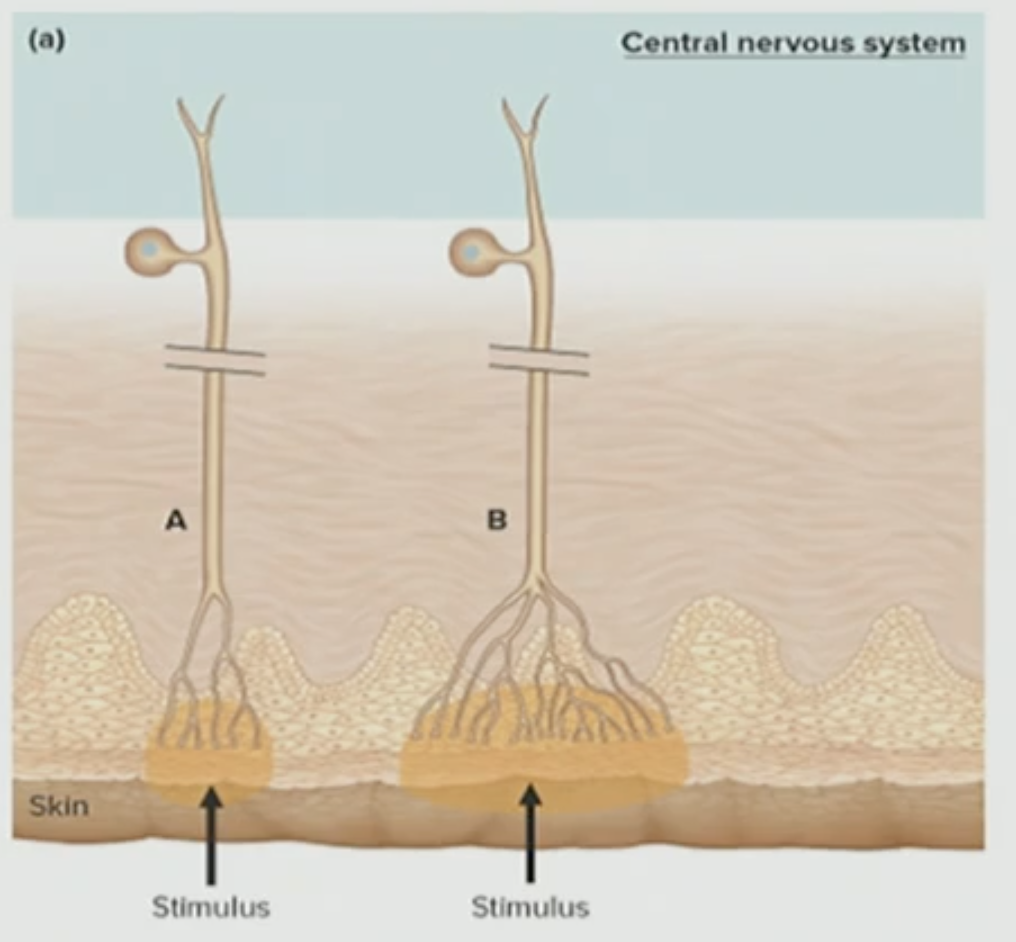
What are these?
Touch sensitive neurons
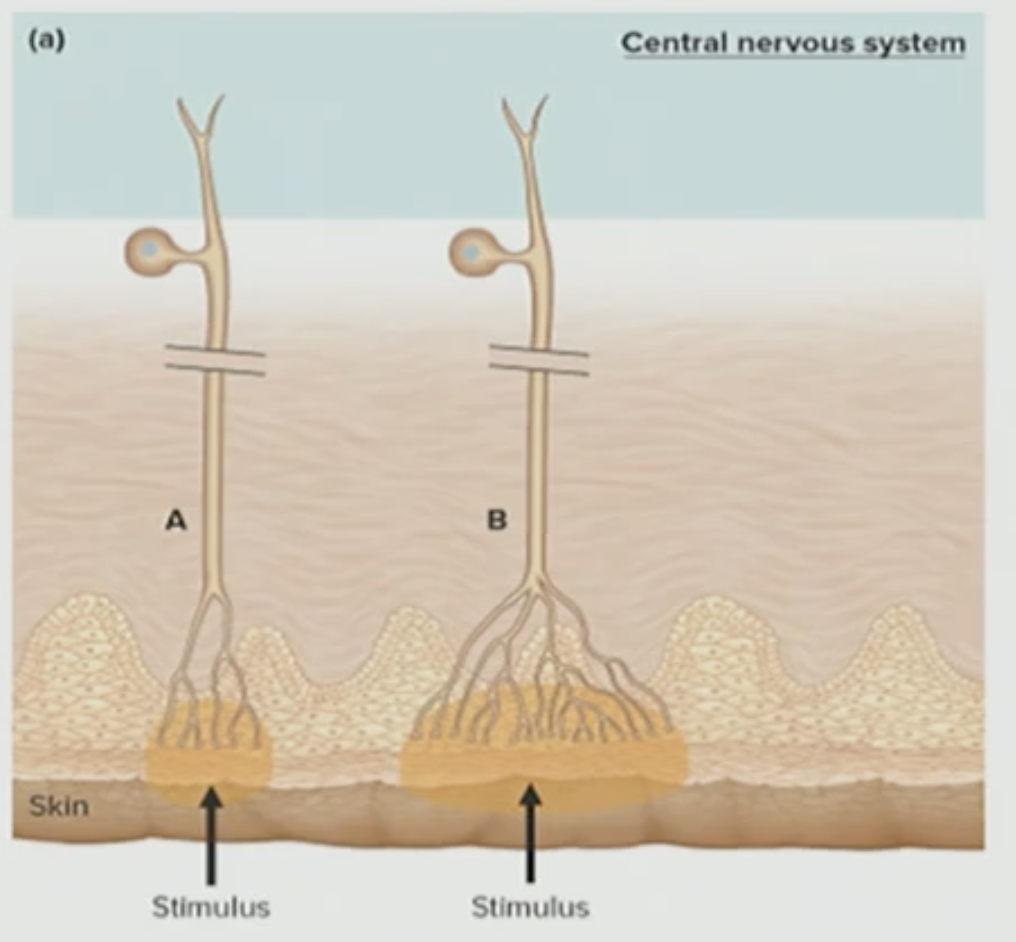
What has a larger receptive field A or B?
B
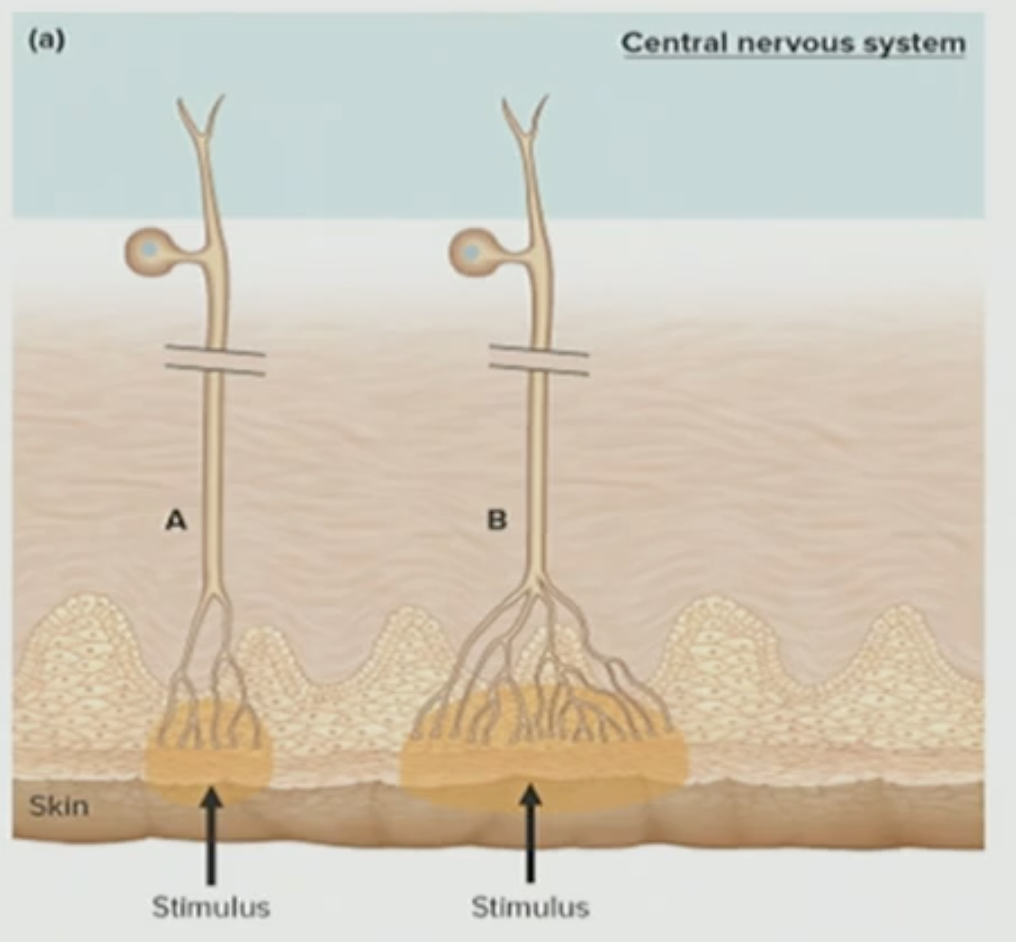
Which receptive field detects fine detail?
A
Finger
detects all the fine detail (A)
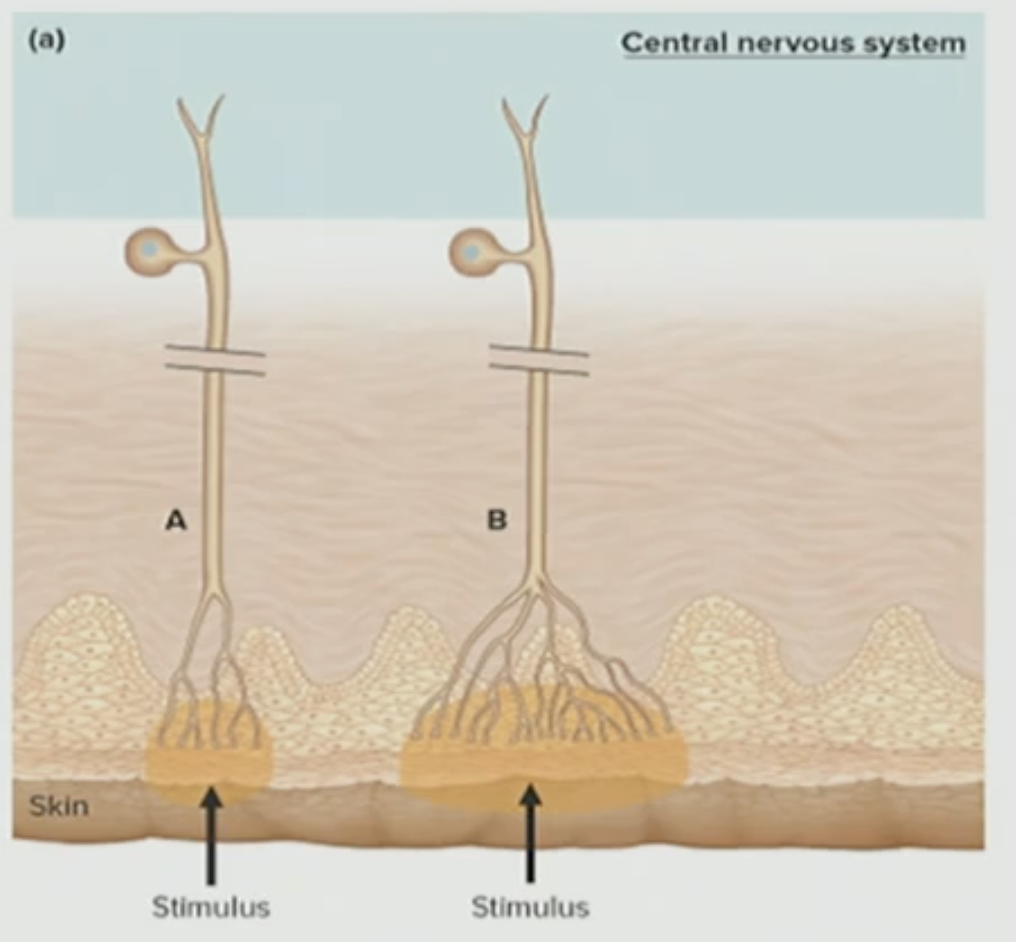
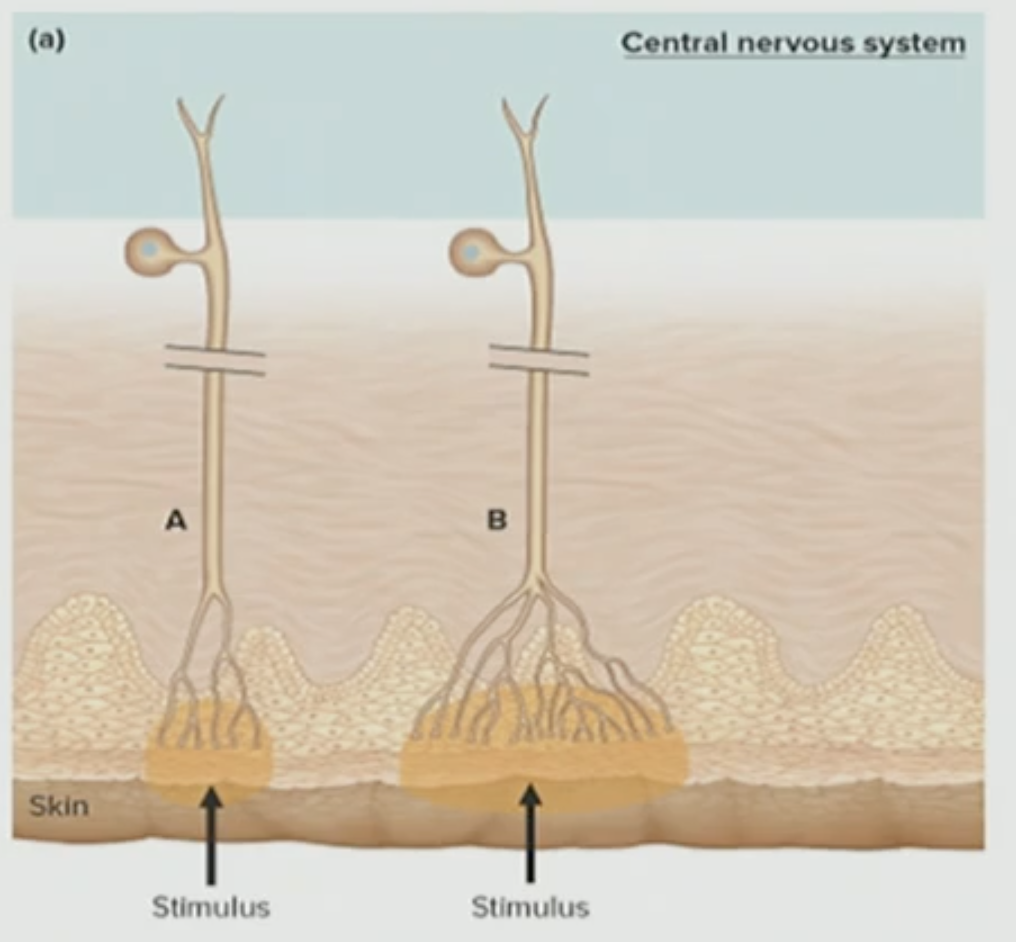
What is the point of the large receptive field (B)?
For sensitivity like in the dark where it detects low intensity stimuli
Low-intensity Stimuli
barely touch something, but become alert to it like a mosquito or fly on you
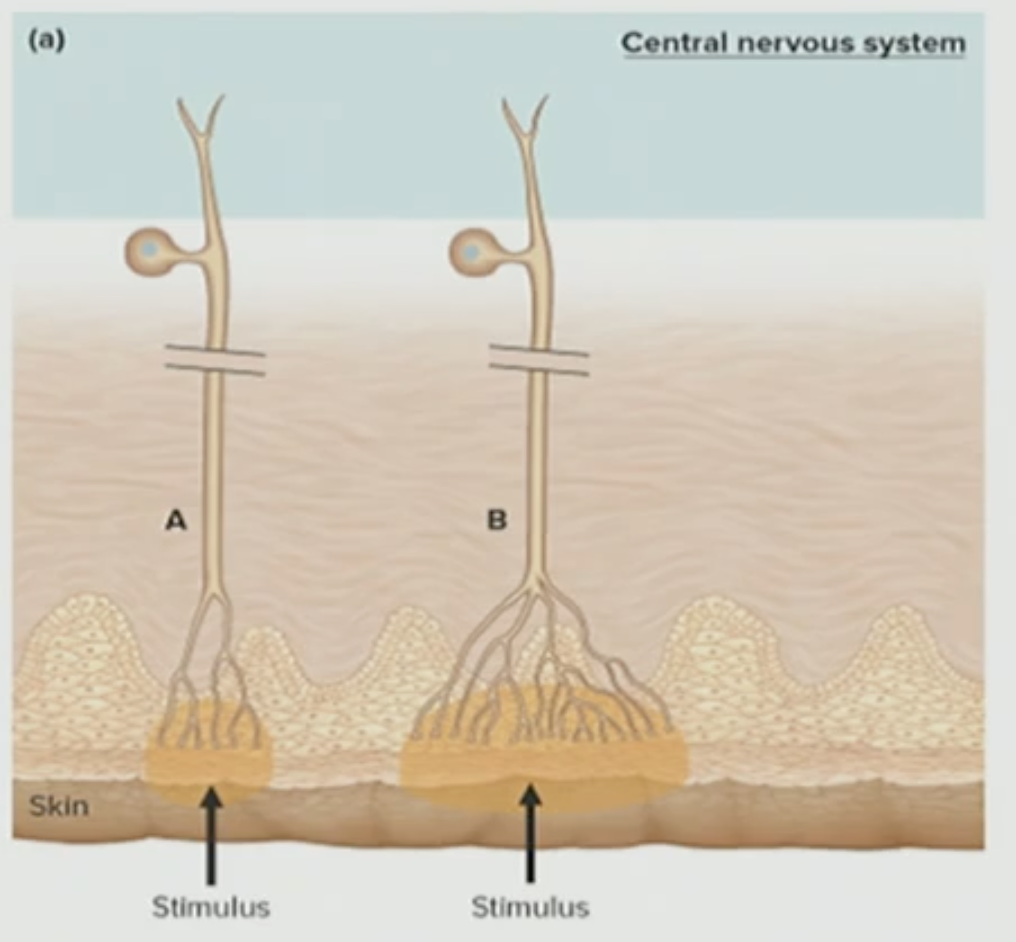
Small Receptive field (A)
Gives you high acuity, ability to detect fine detail
Modality
Type of stimulus (lightwaves, soundwaves)
T/F: Receptors are modality specific
True, you need specific receptors to detect things are receptors are modality specific
T/F: Receptors cannot code the stimulus intensity
False, Receptors can code the stimulus intensity
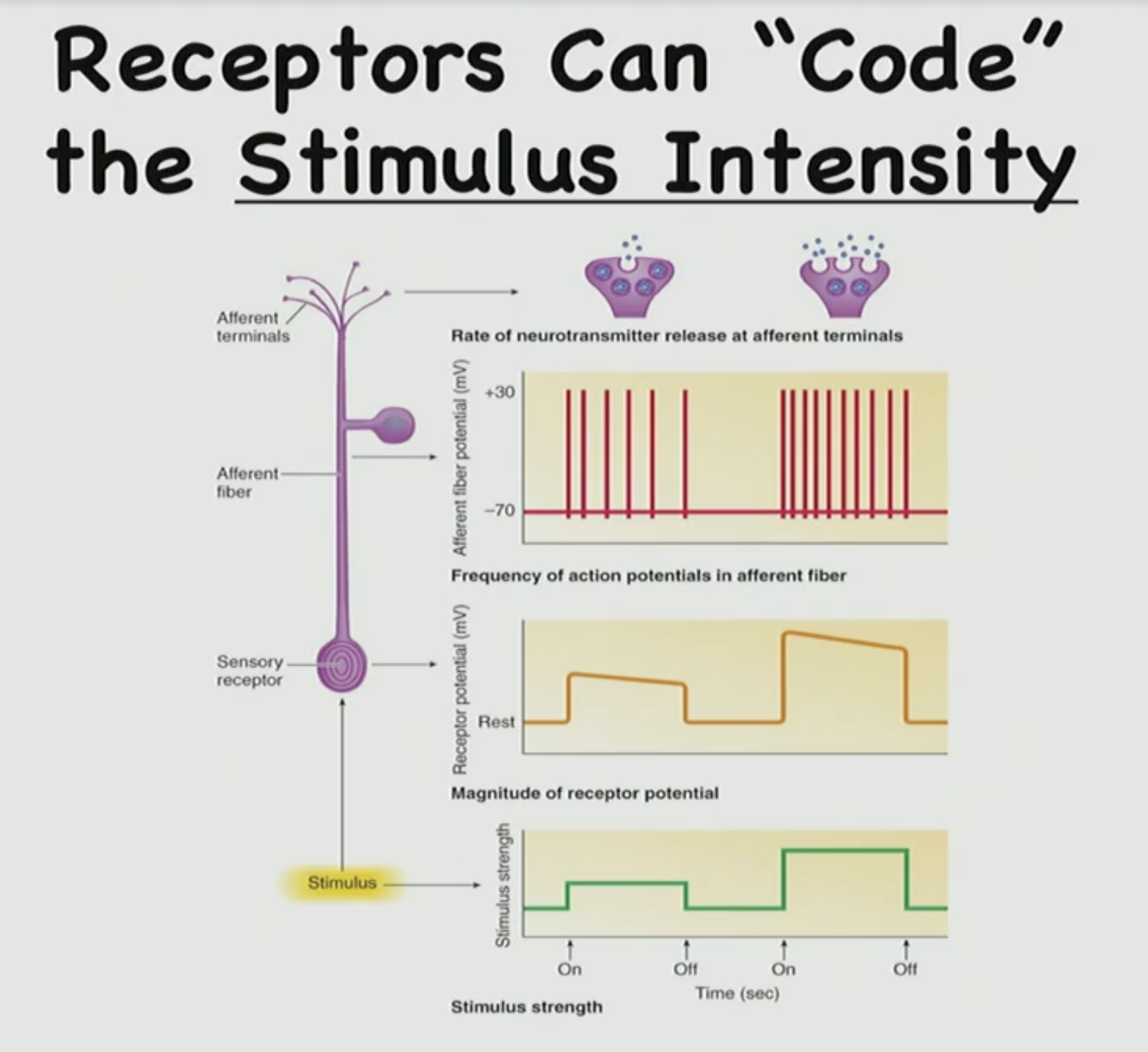
Which one has a stronger stimulus left or right side
The right side
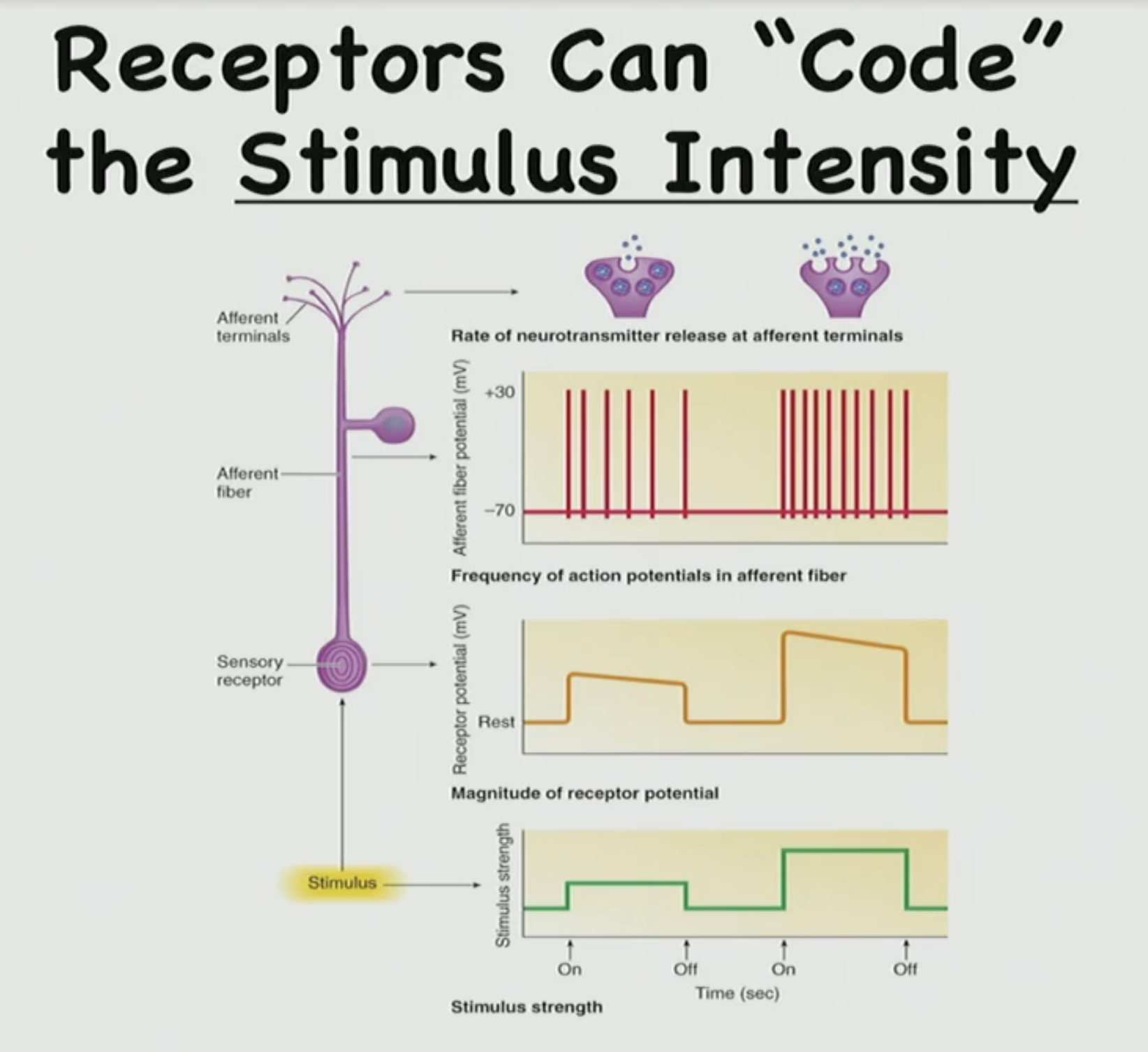
The right side has a ___ AP frequency, which corresponds to the ___ of the stimulus
higher, strength
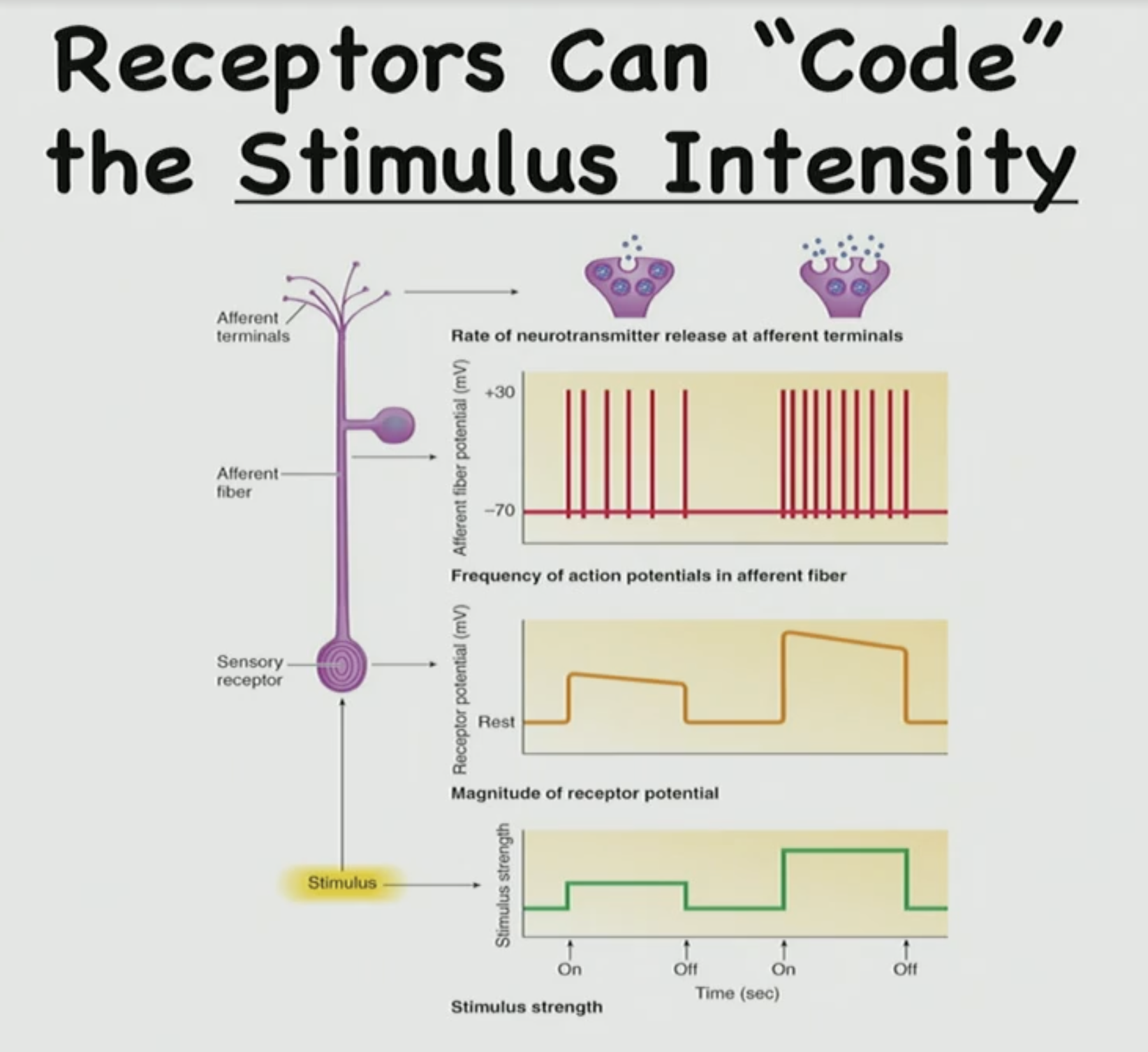
Is there a change in the heigh of the APs
No
T/F: when we want to detect the strength of a stimulus we do it according to the frequency of the AP
True, we detect the strength of a stimulus according to the frequency of the AP as the lower the frequency=weaker stimulus, higher frequency=stronger stimulus
T/F: The larger the receptive field the less the acuity
True, this means if you put a stimuli on your back will you know exactly whats going on back there? no you would not so there is less acuity/sensitivity (precision to detect stimuli)
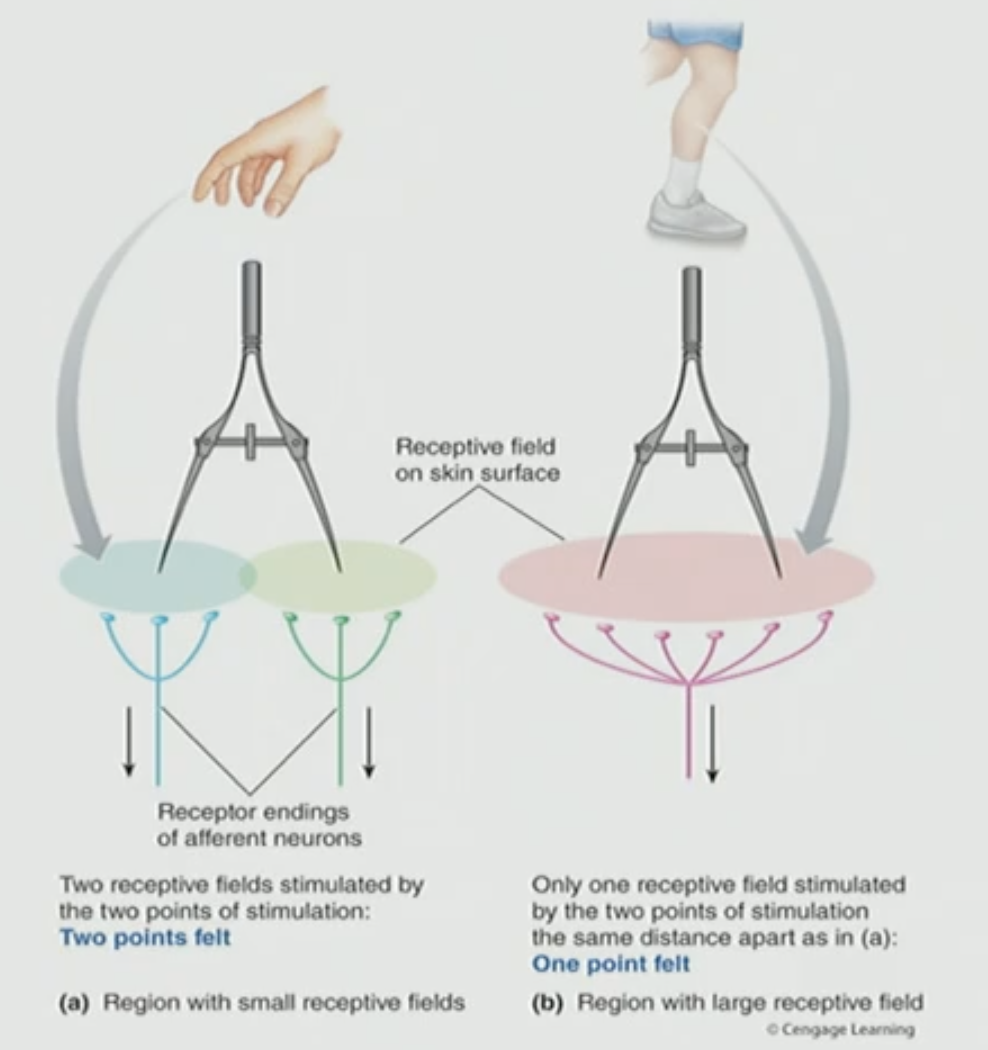
Adapting
Some receptors adapt to extended stimuli
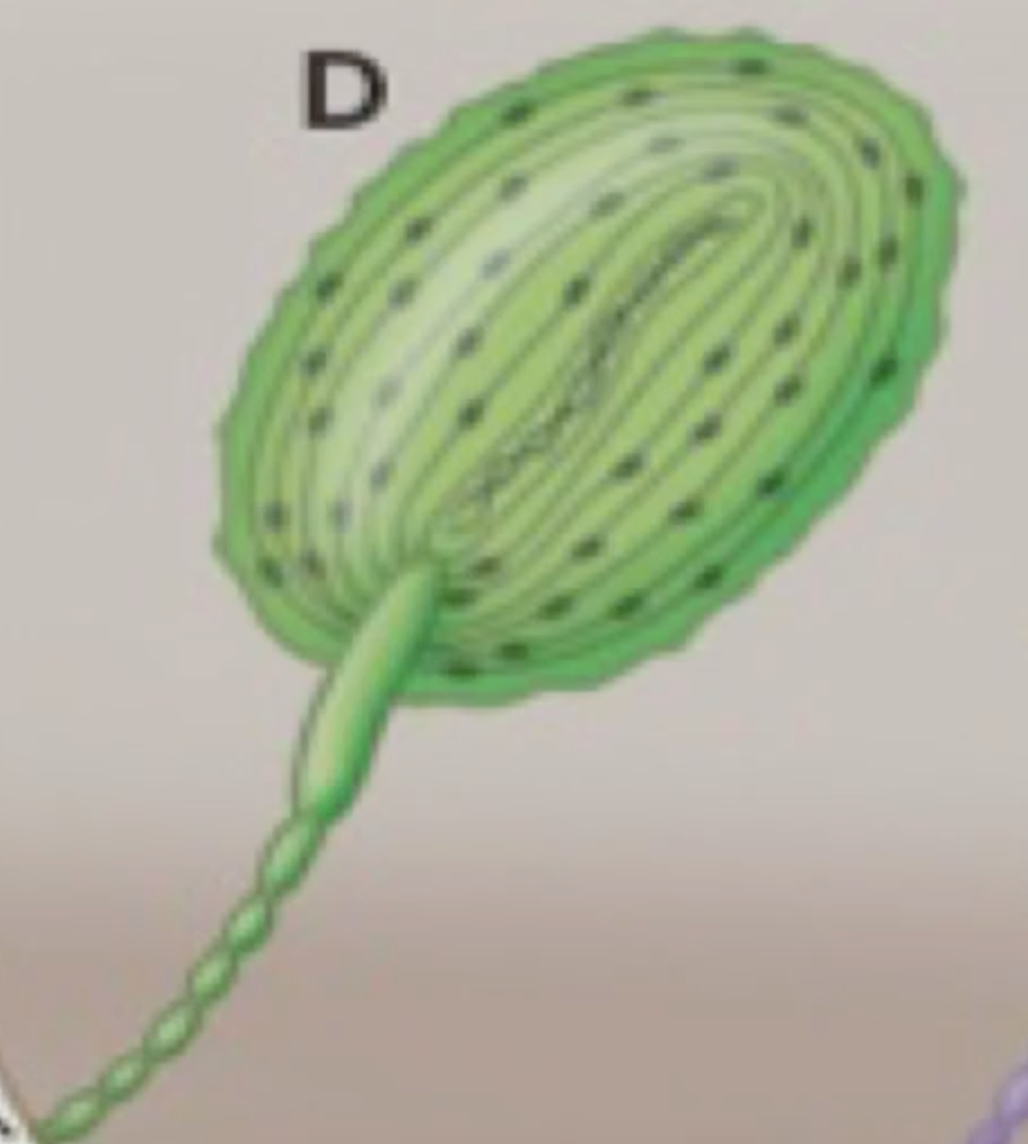
What does this do and whats the name?
This is the Pacinian Corpuscle & it shows the initial firing off and then it doesn’t fire anymore
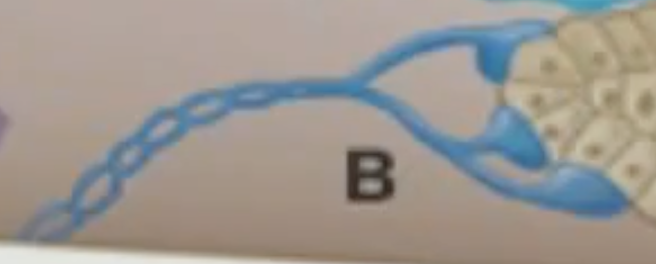
What does this do and whats the name?
This is the Merkel’s corpsucle & it fires for a long period of time
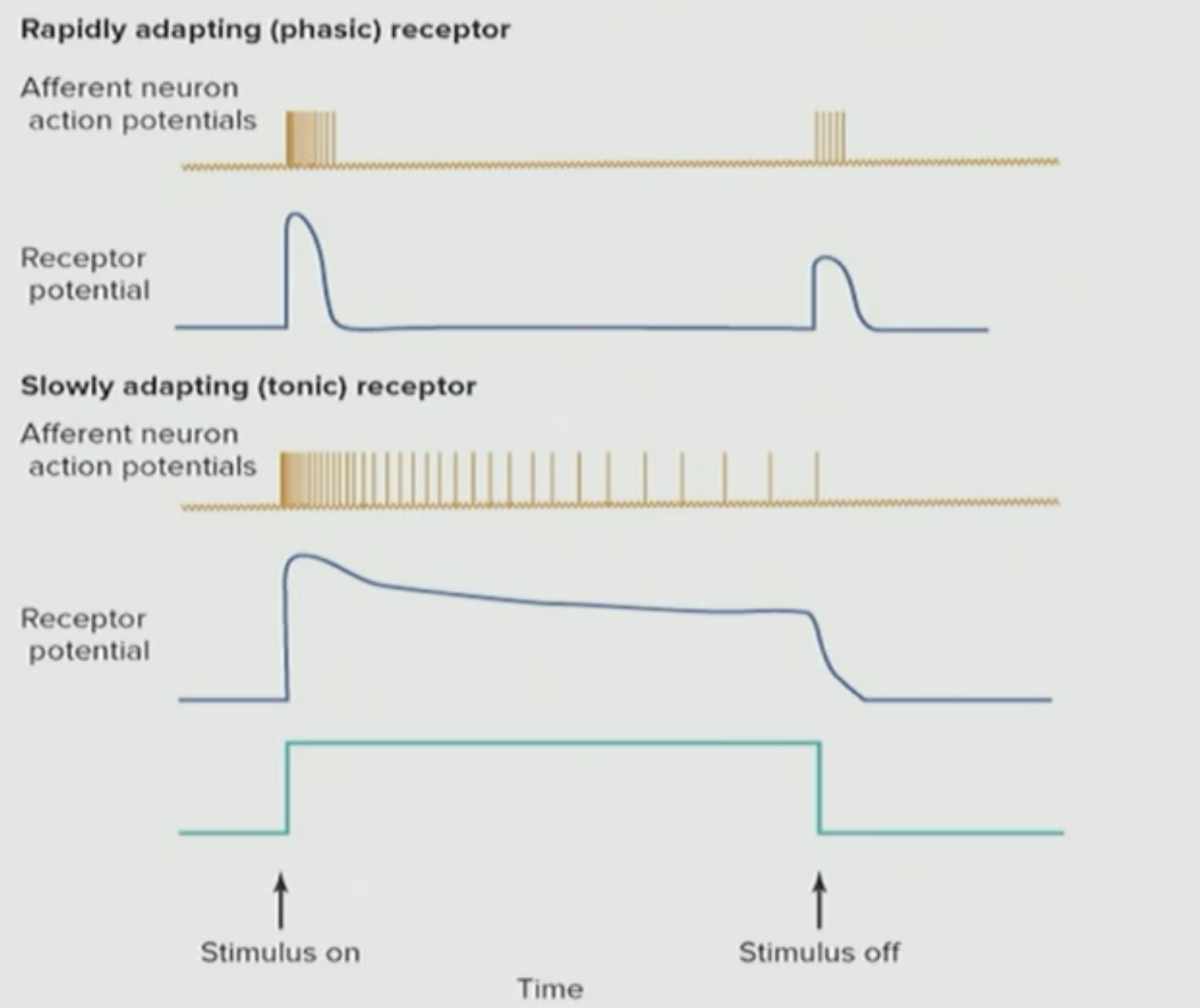
What is occuring here
Stimulus turn on, but then theres no change in stimulus this is because there is an unchanging stimulus where a neuron will fire AP and then AP die off & then fire AP again

T/F: We are exposed to unchanging stimuli
True, us sitting is an unchanging stimuli as we first feel it (pressure of chair), but then don’t notice it anymore and then when we sit up we fill the release of the pressure so it fires AP this occurs with (Pacinian Corpuscle)
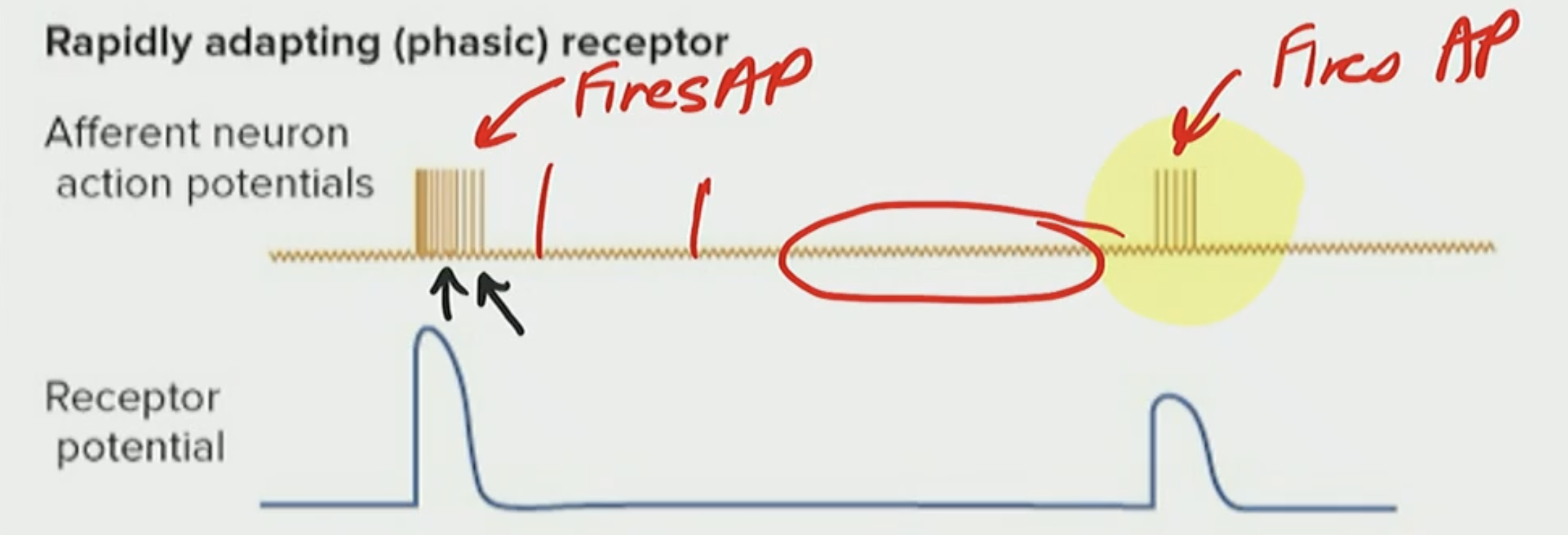
Rapid Adapting Receptor
Quickly fire then shut off and then fire again
Rapid Adapting Receptor Example
Being exposed to a stimuli like you sitting down, that creates an AP and then the neuron doesn’t fire anymore because your body got used to the feeling of the chair under you, then as you stand up the neuron fires off an AP because you feel the pressure release from your bottom
Modality Specific- Pacinian corpuscle: Vibration & Deep pressure
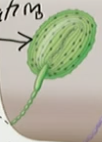
T/F: Rapid Adapting Receptor are touch sensitive
True, Rapid Adapting Receptors are touch sensitive as when you first touch something an AP immediately fires off then the rate of the stimulus remains constant
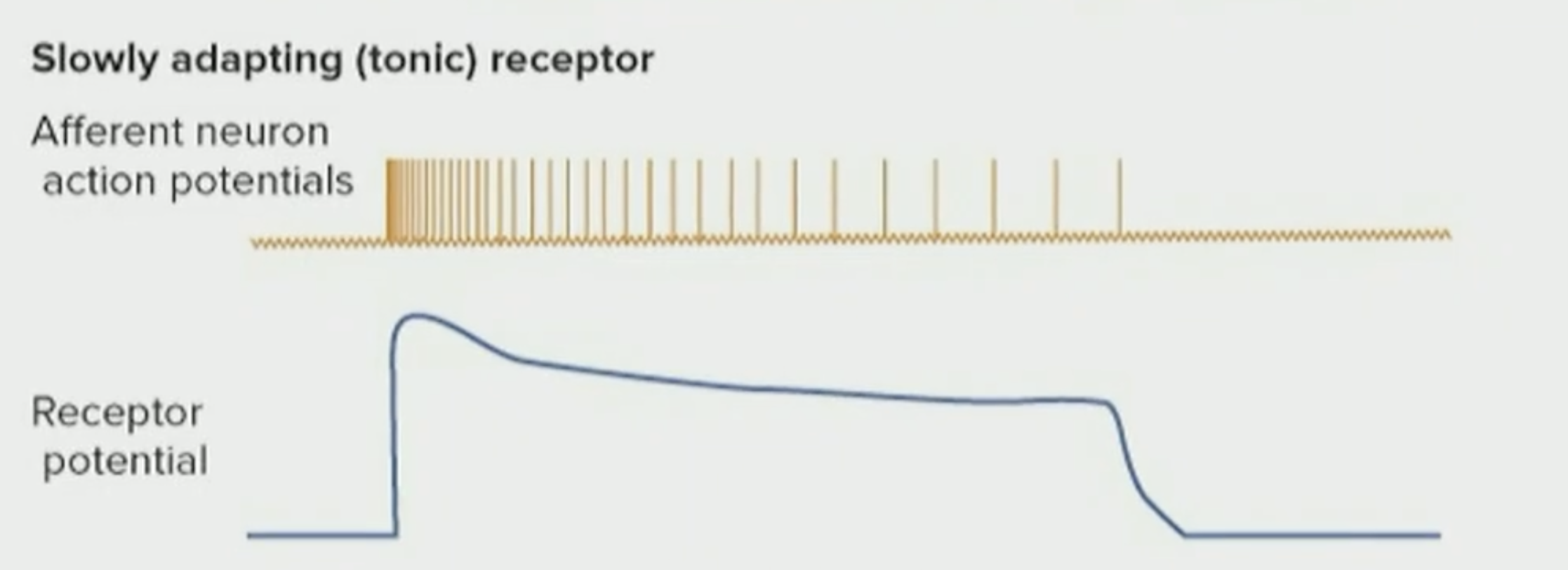
Slowly Adapting Receptor
neuron constantly fires and fires & then when you shut off stimulus it stops firing
Slowly Adapting Receptor Example
Detection for fine detail that will constantly fire
Merkel’s corpuscle: touch & pressure
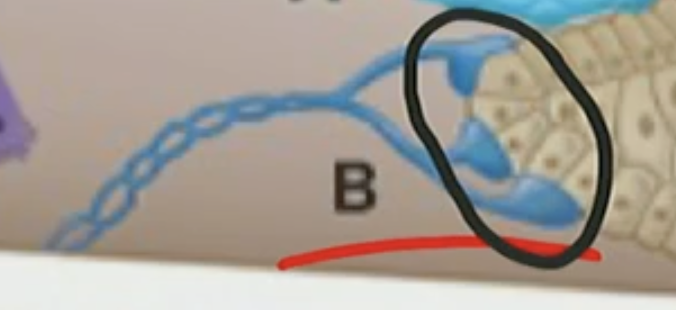
T/F: There are receptors that aren’t continually firing off
True, there are receptors that aren’t continually firing off constantly throughout which are called rapid adapting receptors
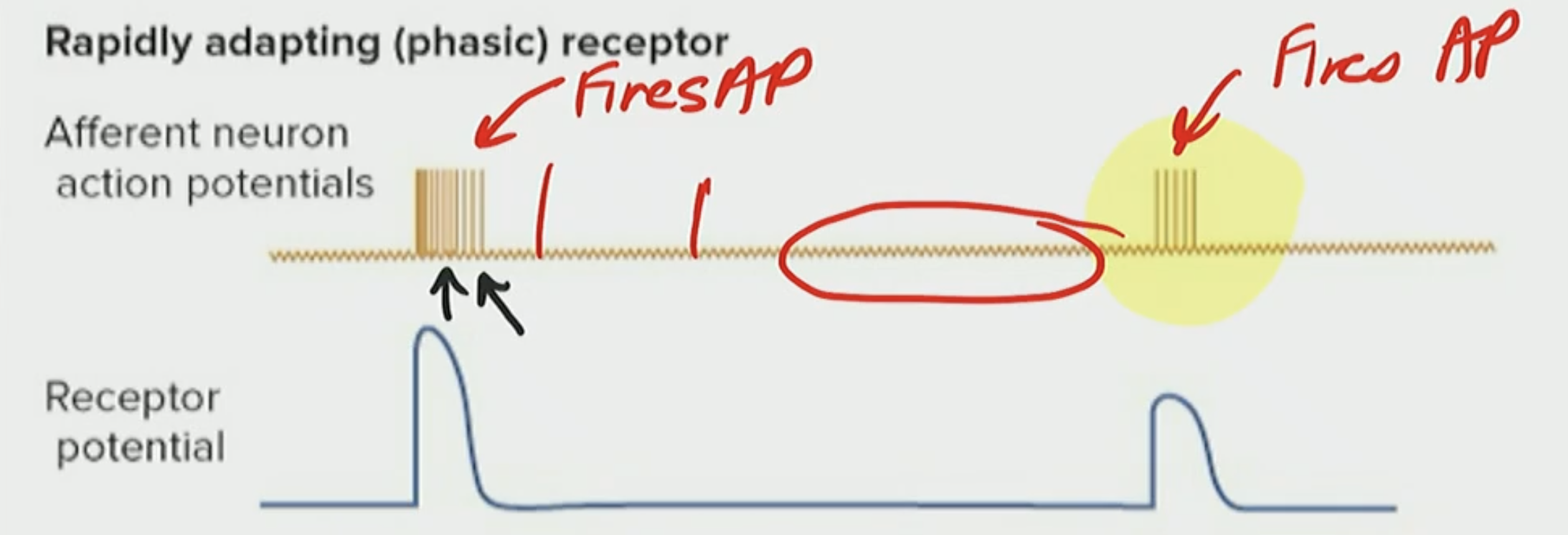
T/F: There are receptors that are continually firing off
True, and these are called slowly adapting receptors as it has a receptor when we are in pain and it continues to hurt after the initial pain
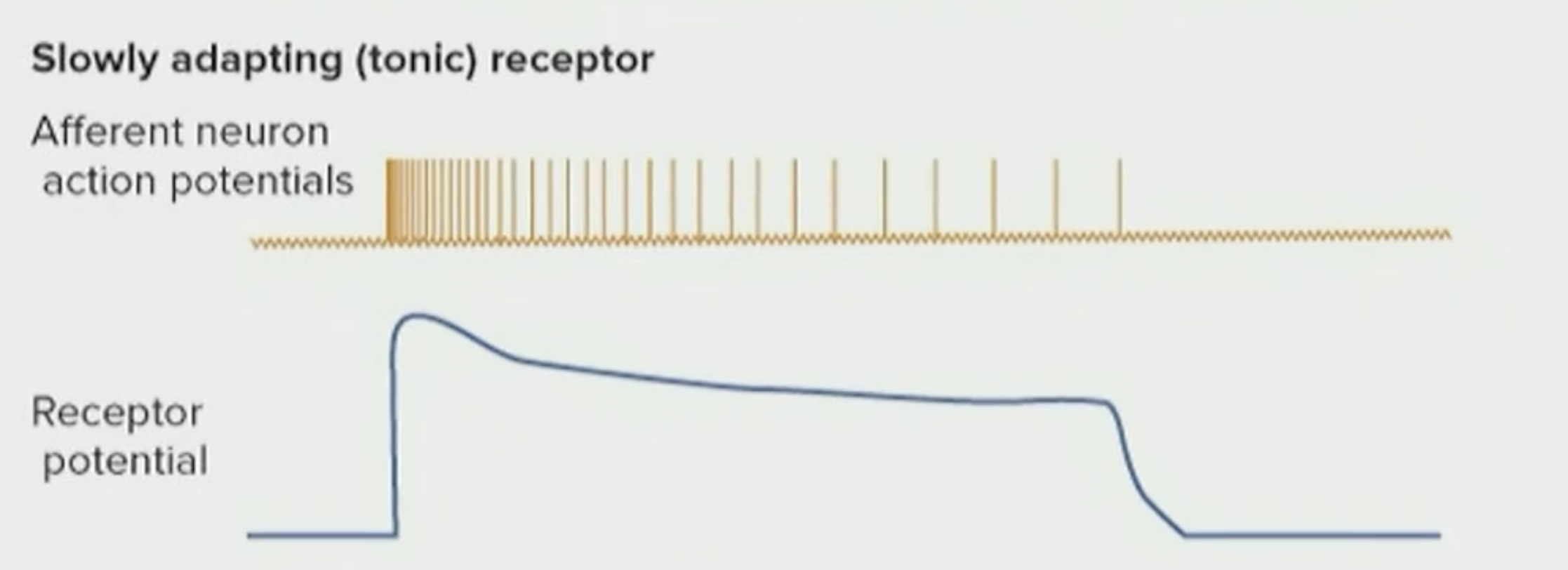
Merkel Receptor
Doesn’t rapidly adapt as it’s important for reading braille & doesn’t rapidly adapt as it slowly adapts
T/F: A lot of receptors either slowly or never adapt to the extended stimulus
True
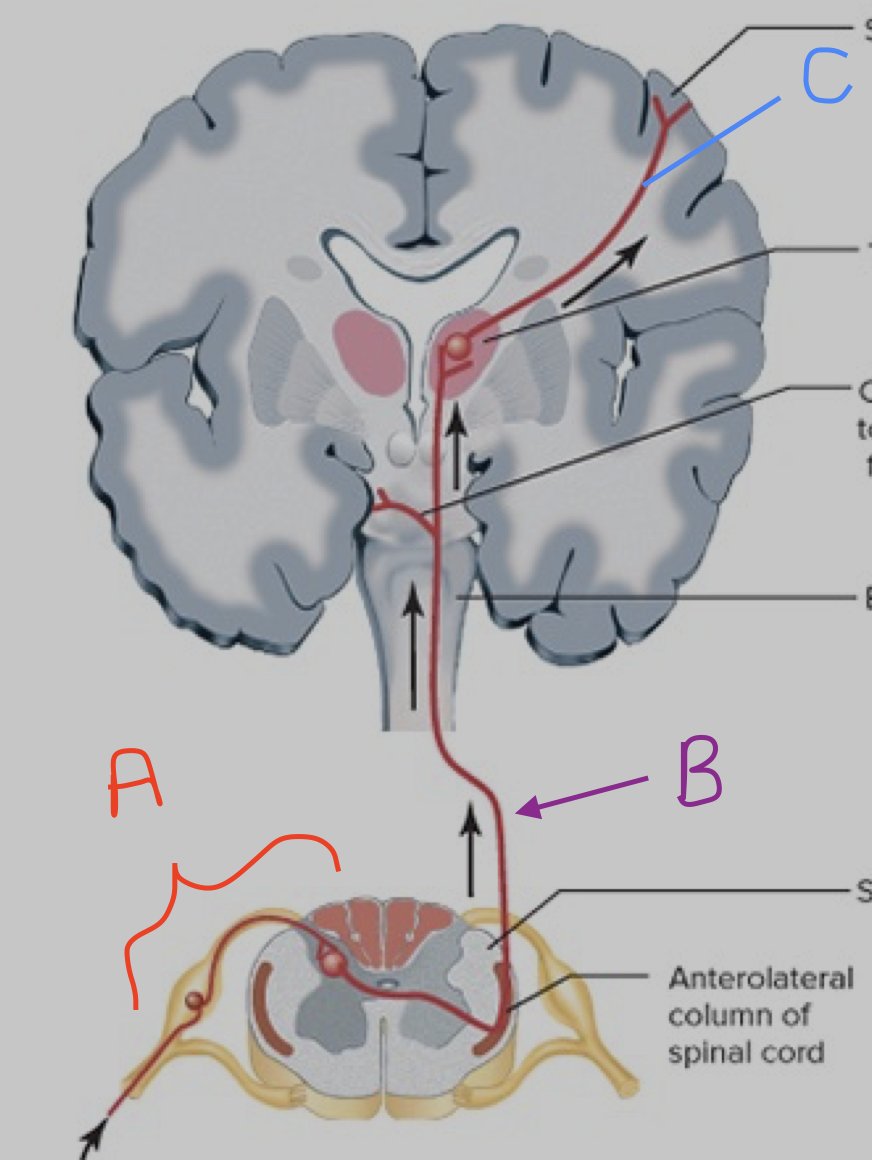
Is B Primary(1st), Second (2nd) order, or Third order afferent neuron
This is the secondary order afferent neuron
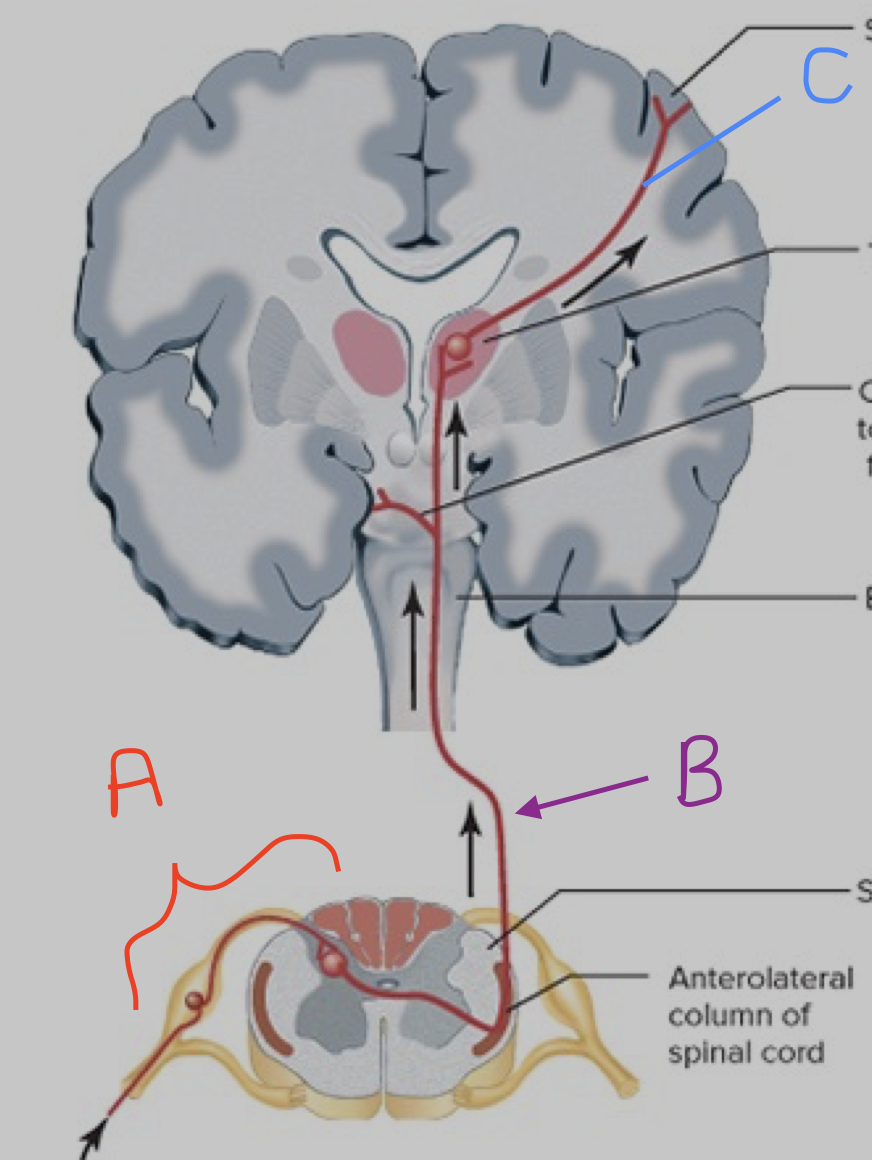
Is C Primary(1st), Second (2nd) order, or Third order afferent neuron
This is the Third order afferent neuron
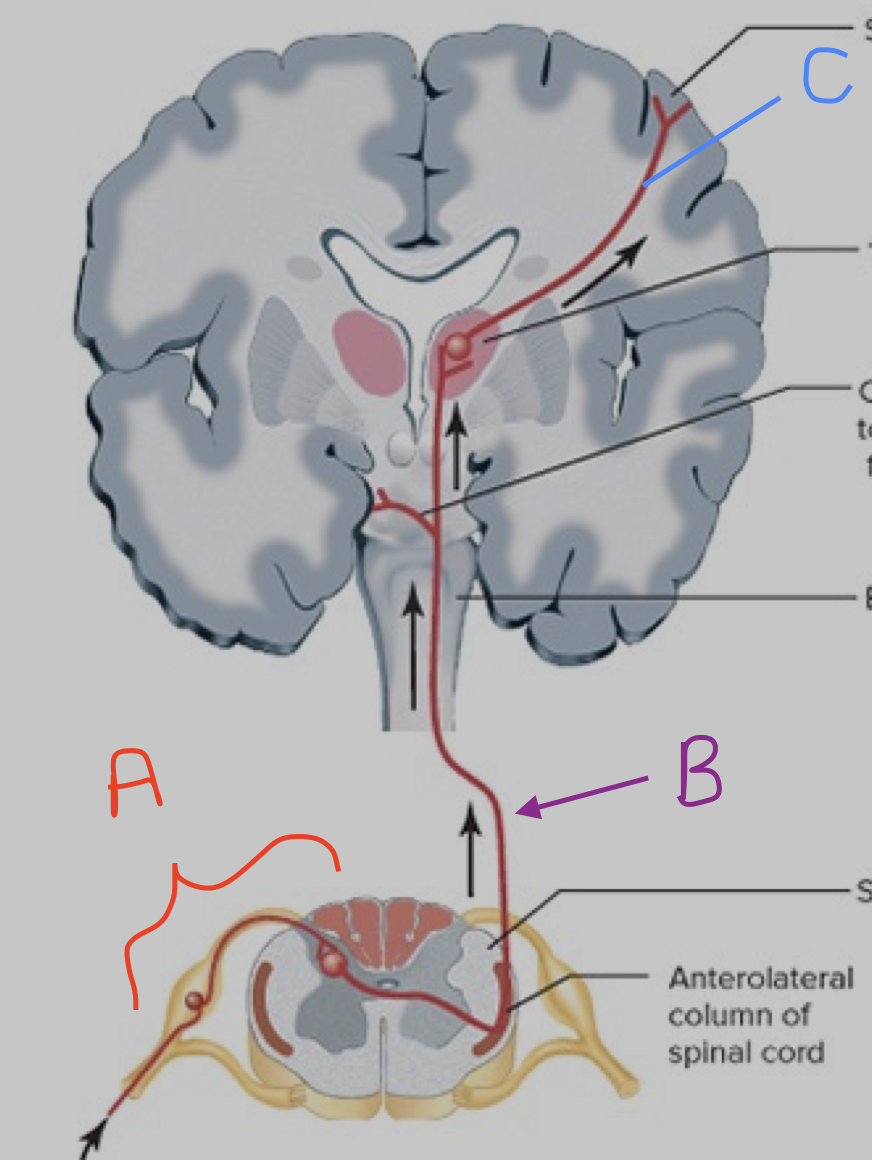
Is A Primary(1st), Second (2nd) order, or Third order afferent neuron
This is the Primary afferent neuron
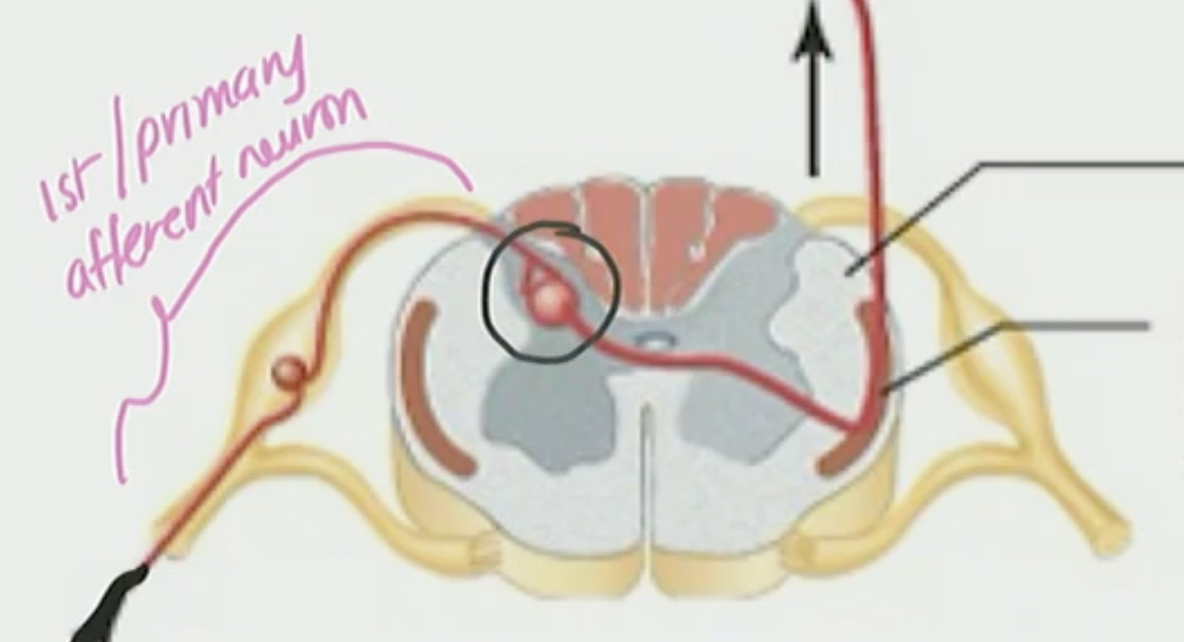
Primary Afferent Neuron
afferent neurons forms a synapse
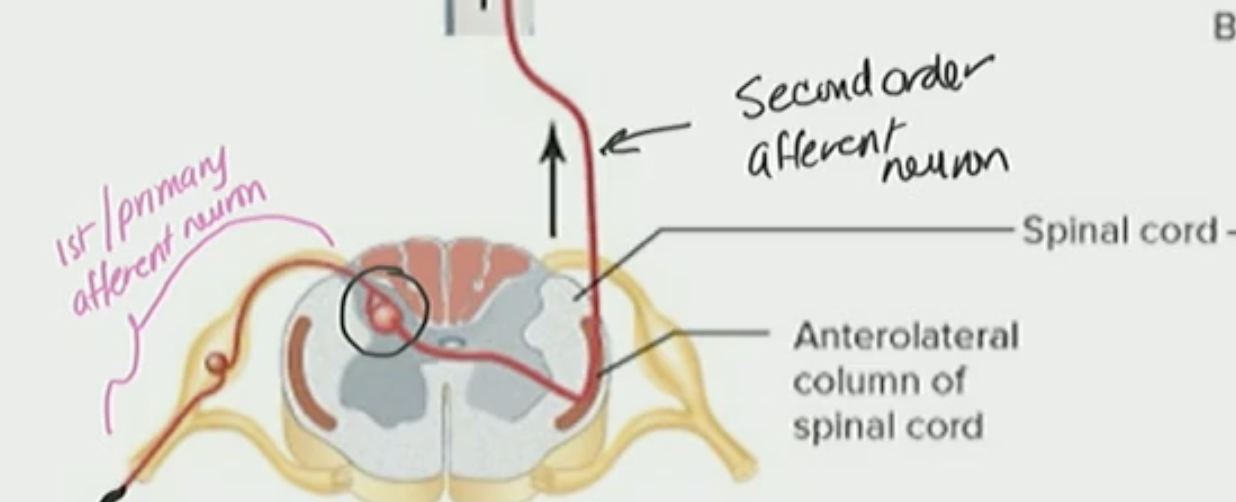
Secondary Order Afferent Neuron
Afferent neuron from Primary that formed a synapse will connect to second order neuron in spinal cord which this second order afferent neuron will then project and send its information to the thalamus (third order)
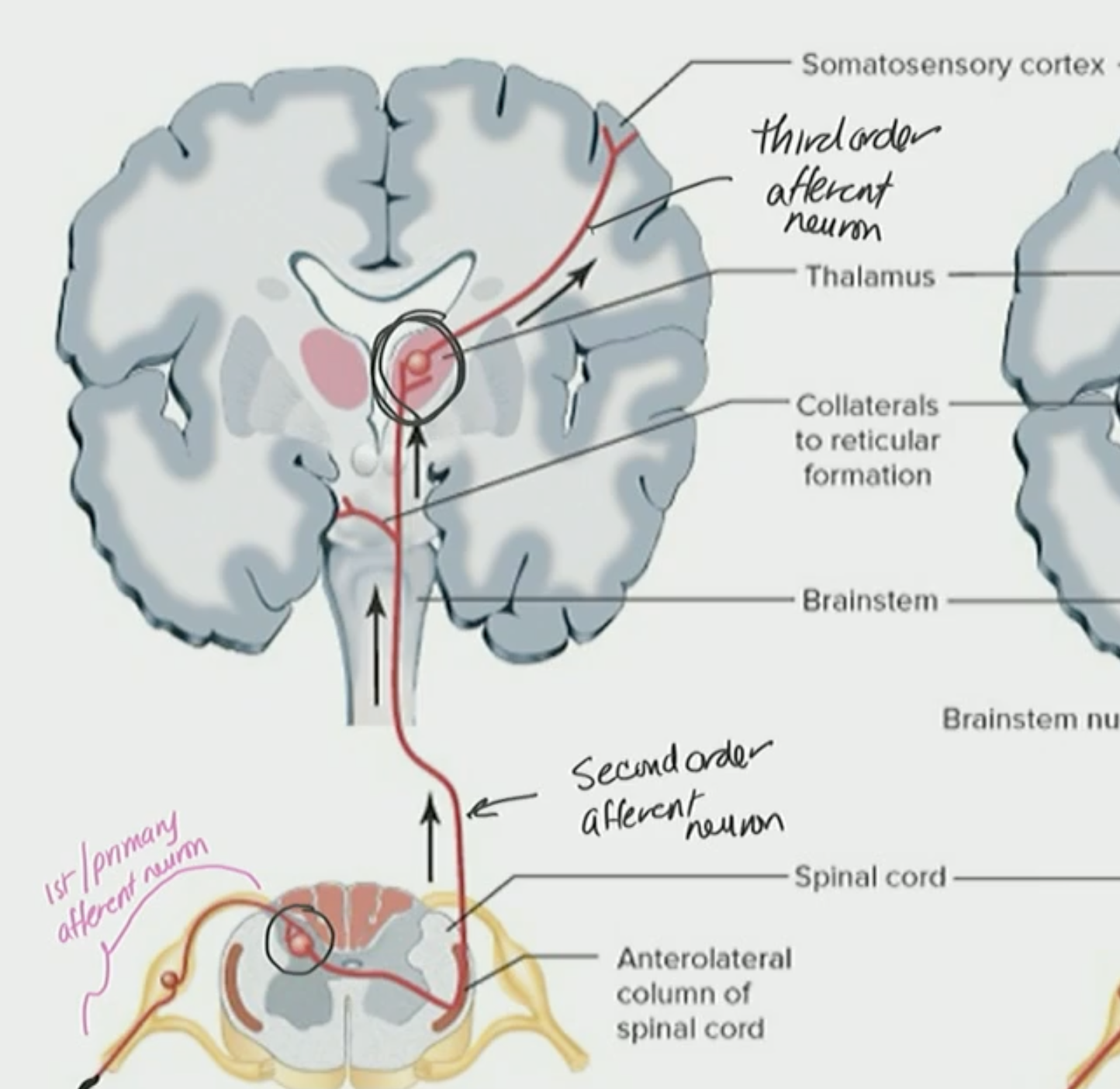
Third Order Afferent Neuron
Secondary Afferent neurons projects and sends its information to thalamus where it synapses. a third order neuron and takes the stuff to the the somatosensory cortex (only if we consciously perceive it)
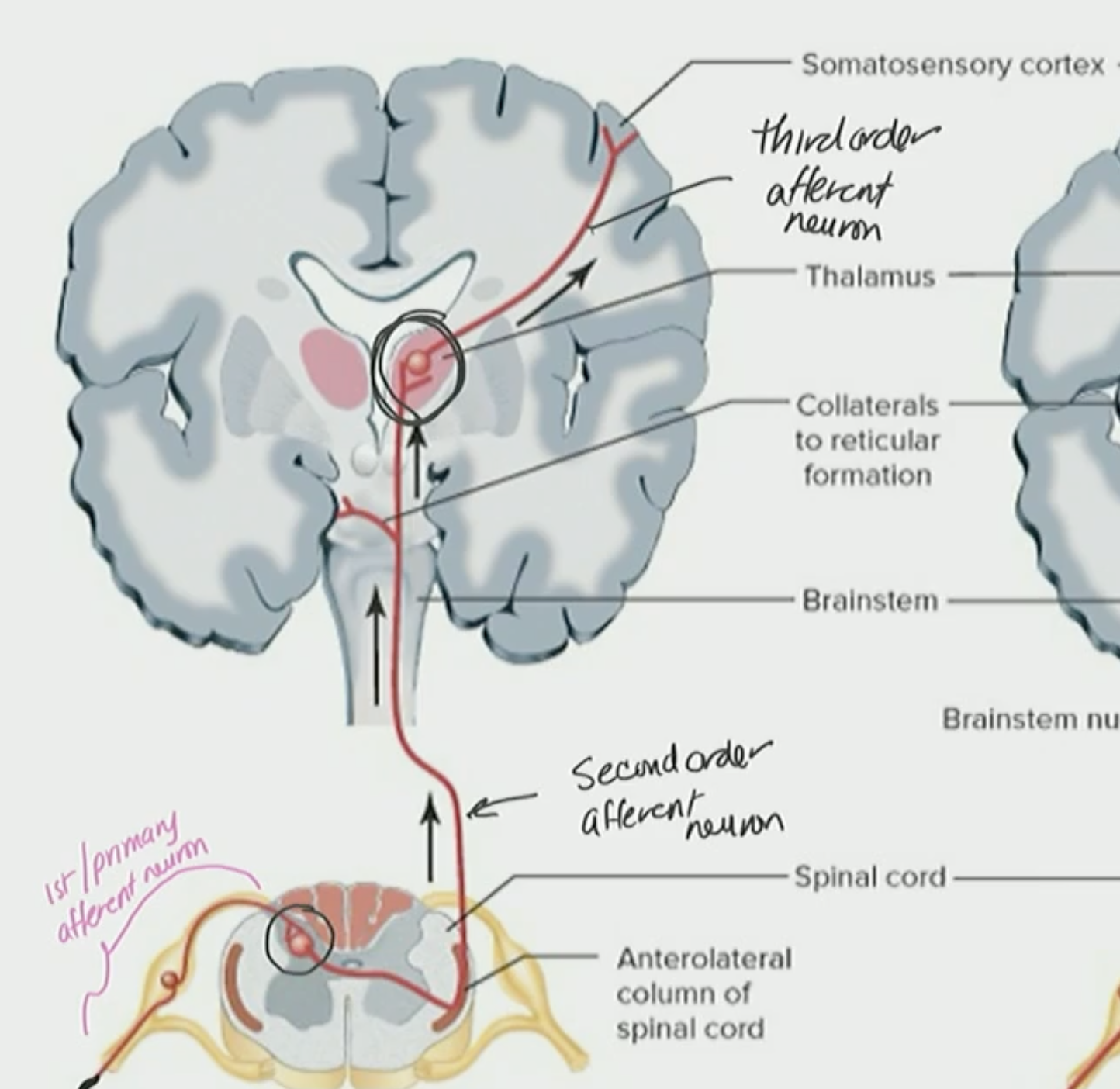
Primary, Secondary, Third order afferent neuron process
Primary afferent will form a synapse and it will connect to the second order neuron in the spinal cord which it then projects & sends information to the thalamus where the third order neuron where it will form a synapse (neuron transmitting signal to another neuron) and the third order will then take the stuff to the somatosensory cortex (only if we consciously perceive it) where we process that information in the opposite cortex (cerebrum processes it)
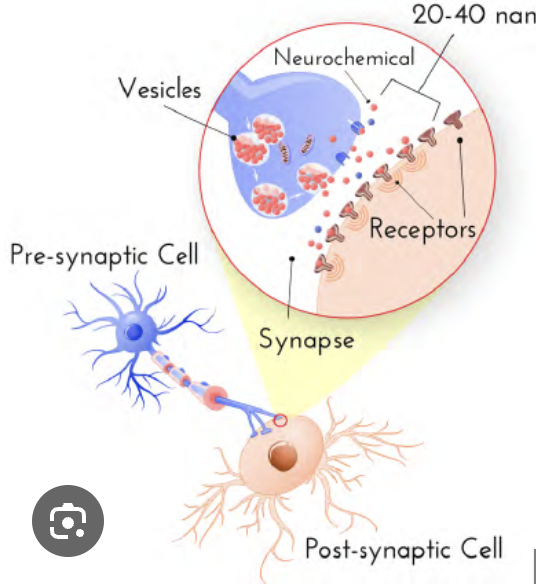
Synapse
A synapse is the connection point where a neuron (nerve cell) transmits a signal to another neuron or a target cell like a muscle or gland
Crossing over
Primary afferent will form a synapse and it will connect to the second order neuron in the spinal cord which it then projects & sends information to the thalamus where the third order neuron where it will form a synapse (neuron transmitting signal to another neuron) and the third order will then take the stuff to the somatosensory cortex (only if we consciously perceive it) where we process that information in the opposite cortex (cerebrum processes it) (right toe to the left side of the cortex)